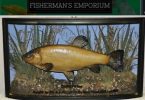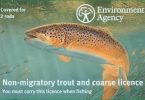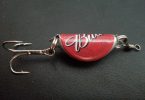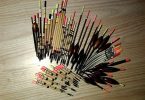On October 7, 1922, Georgina Ballantine achieved a feat which remains unequalled to this day, despite concerted attempts by millions of anglers. Fishing from a boat on the Glendelvine stretch of the River Tay in Scotland, she cast her spinning tackle into the Boat Pool. At 6.l5pm, her bait was taken by her fourth salmon of the day, an extremely large and powerful fish which tested her tackle and her angling skills to the limit. Eventually, after a battle which lasted almost two hours, the leviathan was landed successfully half a mile downstream.
The salmon weighed 64lb and measured 54in. from snout to tail, with a girth of 28½in. Such was its size and strength that Miss Ballantine said her arms remained swollen for two weeks afterwards! Today, her salmon still stands as the British rod-caught record for the species, as well as being the largest authenticated freshwater fish ever landed by an angler in the British Isles.
Whether or not her success inspired other women to emulate her is unknown. What is certain is that, within two years, a Mrs Morison took a 61lb salmon from the Deverton and a Miss Doreen Dovey caught a 59k-pounder from the River Wye at Lower Winforton. Since then, many women have been encouraged to take up the various branches of the sport, fishing alongside and even, in some cases, competing against their male contemporaries.
Although the sport is often thought of as a male preserve, it is a fact that there may be 300,000 women who are active anglers, a statistic derived from recent market research. No longer are girls who go fishing regarded with suspicion or disdain.
Many young men possess what appears to be a natural, almost instinctive interest in the hunting nature of angling, and it is this which stimulates their initial participation in the sport. To suggest that this psychological trait is absent from young women would be pure speculation. What we do know is that, whereas most men first take up the sport in their teens, relatively few women do.
It would be tempting to seek an explanation in the popular notion that the different conditioning of the sexes by parents, schools and society as a whole is what influences their differing styles of life and personal interests at later ages. Even if these traditional ‘boy’ and ‘girl’ roles remained relevant today, such a simplistic explanation would still not account for the recruitment of women anglers later in life.
Most anglers are introduced to angling by relatives or friends. From the personal accounts of avid women anglers, it seems almost certain that their boy friends or husbands were responsible for taking most of them fishing for the first time. What started out as mere curiosity, particularly in what ‘the other half’ got up to on fishing trips, led to shared angling outings and, eventually, a desire to have a go at catching a fish for herself. Thereafter, the pattern of developing interest in angling appears identical to that of men, albeit expressed somewhat differently.
While many men pursue their sport as an individual activity, often fishing on their own in remote locations, the angling experience for women is one more often shared with others. Usually, this is with a boy friend or spouse, but a significant number of women fish together. Most of these outings are on an informal basis, but there are also numerous sea, game and coarse angling competitions for women. At the highest level, more than 150 women compete in the Ladies’ National Championships, organised annually since the mid-1970s by the National Federation of Anglers, and their results match those of their male counterparts.
Although large numbers of women participate in sea and coarse fishing, by far the highest percentage of women anglers is attracted to game fishing, in pursuit of trout and salmon. Among their number are many women well-known to the general public: Diana Rigg, the actress; Faith Brown, entertainer; Fiona Armstrong, newsreader; Jenny Hanley, TV presenter.
To them, and thousands like them, game fishing is an ideal sport. Because of the small amount of fishing tackle necessary to cast a fly – at its simplest, just a lightweight rod, a reel filled with a fly line, and a selection of artificial flies – a game angler is mobile and is able to search for feeding fish, rather than waiting for them to come to him or her (as with most forms of coarse or sea fishing). Consequently, a successful game angling session may be highly active and of relatively short duration.
For many forms of sea and coarse angling, it is preferable to use invertebrate animals as bait, whereas there is generally no such need in game fishing, for which artificial flies or metal and/or plastic lures are the standard baits (and, often, the only permissible ones). Moreover, while it is not usually cited by game anglers as one of their prime motives, most do also like the prospect of practising their culinary skills on freshly-caught trout or salmon.
All this being said, the fact remains that women still represent barely ten per cent of the angling community. Yet those who do enter the sport are often extremely successful, as Moc Morgan, secretary of the Welsh Salmon and Trout Association, acknowledges: “When they are good, women anglers are very, very good – far better than most men, for some reason.”
Why, then, don’t more women take up angling? Here are some of the answers customarily given, coupled with practical suggestions which might help to correct this gender imbalance:
‘Women don’ t like touching slimy creatures.’
If we accept that women are more squeamish than men about handling wet, cold-blooded and, sometimes, slime-covered creatures, this can only have arisen because of their conditioning at early ages. As a consequence, it will prove impossible to alter the reaction of women to fish until the attitudes of parents and schools have been changed. Direct contact with fish, in a non-angling context, may help: young people who otherwise appear scared of animals quickly overcome this aversion when they are taught more about and can actually touch the creatures involved (hence the popularity of school trips to working farms).
‘Angling is boring.’
To the casual observer, the apparent inactivity of an angler practising one of the more sedentary styles of angling may appear boring. When asked, the angler will often admit that his or her ‘concentration’ is, in fact, controlled impatience. If explanation is given of what the angler is doing and what he or she is hoping to achieve, the onlooker soon sees that, to tempt a wary fish to take the bait, it is important to avoid unnecessary physical movements and undue noise, just as it is when bird watching.
‘Angling can be cold (or wet).’
Any sport or pastime which takes place outdoors is influenced by the weather, and angling is no exception. However, the duration of an angling session is determined solely by the participant, except in organised fishing contests, and can therefore be timed to avoid inclement weather.
‘Angling requires great physical effort.’
Most forms of angling do not depend for success on fitness or muscle tone. Anglers may, from preference, elect to carry a considerable quantity of tackle with them for a day’s fishing, but it is usually unnecessary to do so. Successful angling does, though, require an intuitive understanding of the elusive quarry, its habits and natural behaviour, and good anglers are highly active mentally.
‘Fisheries lack facilities.’
Women can experience practical difficulties in ‘answering the call of nature’ when in the countryside. Nowadays, many progressive angling clubs and fishery owners are investing in modern amenities by providing toilets and car parks, improving access to their fisheries and creating comfortable fishing areas at the water’s edge, a trend which should be welcomed and encouraged.
To sum up: the fascination of angling, the relaxation it provides, and the contact with nature it encourages, can appeal to both sexes and all ages. The sport is male-dominated only by accident, not by design, and there is no reason at all why its benefits should not be appreciated and enjoyed by ever-increasing numbers of women.
**********
Prepared by: Dr Bruno Broughton
[Latest update: 20 March 2001]







